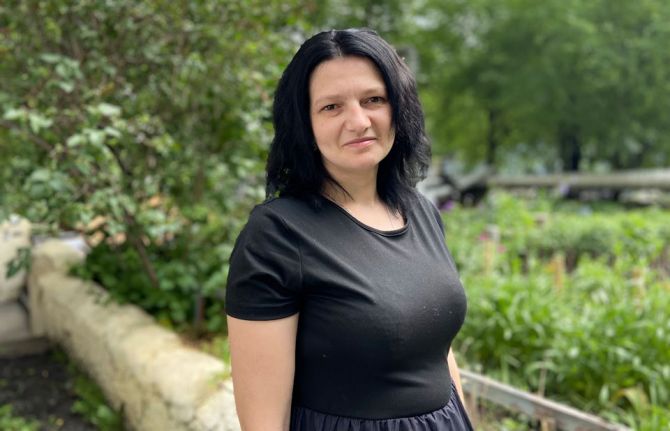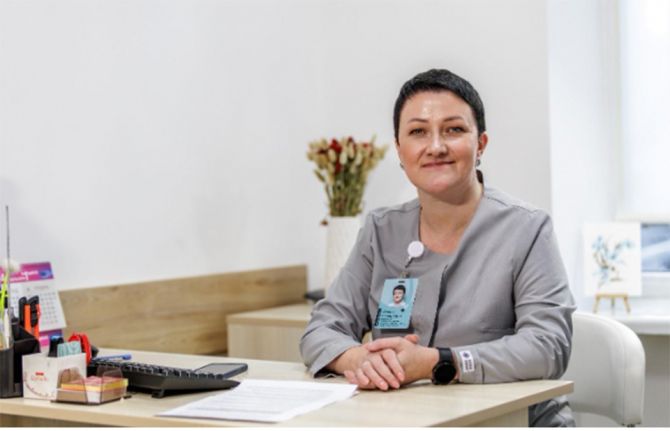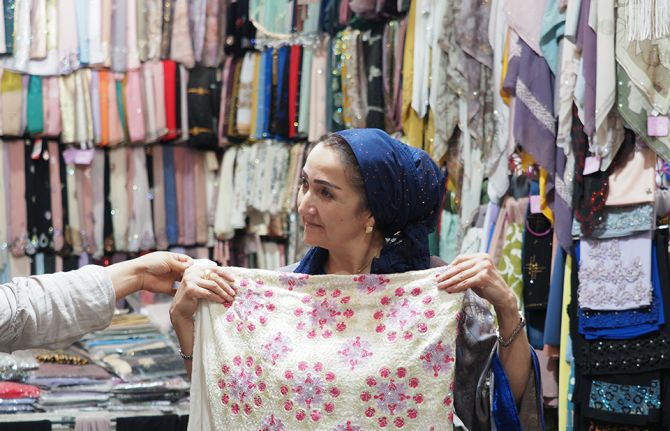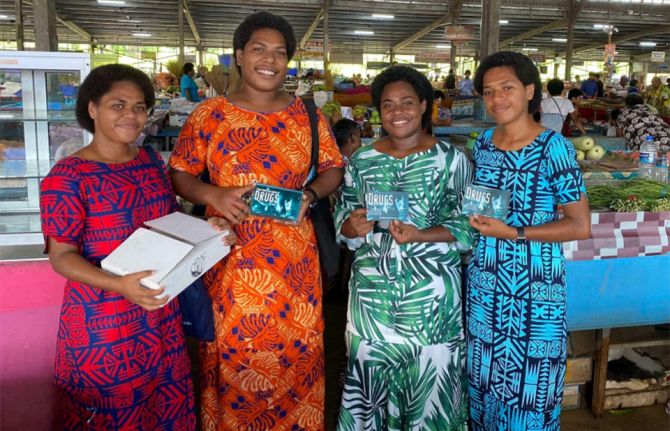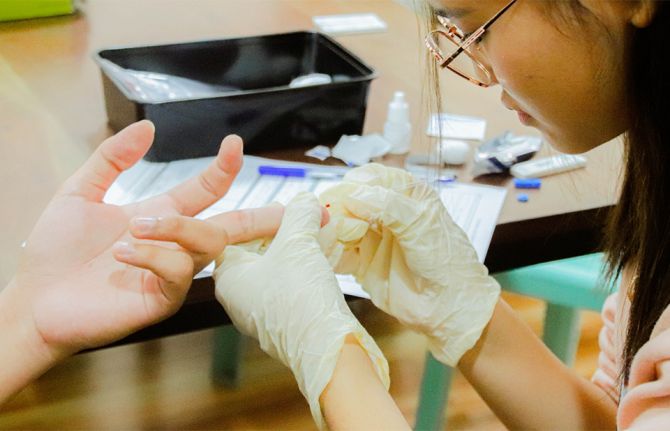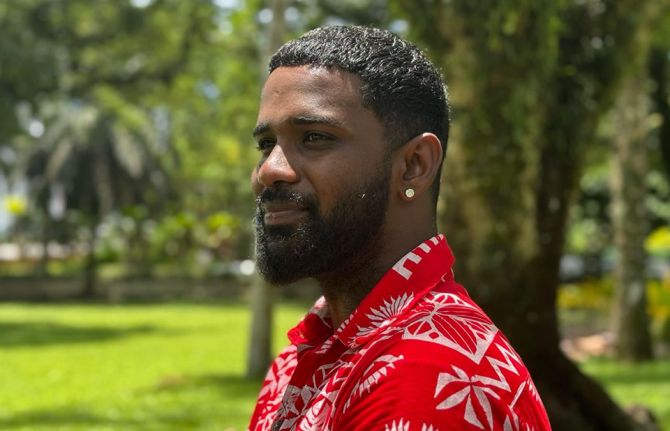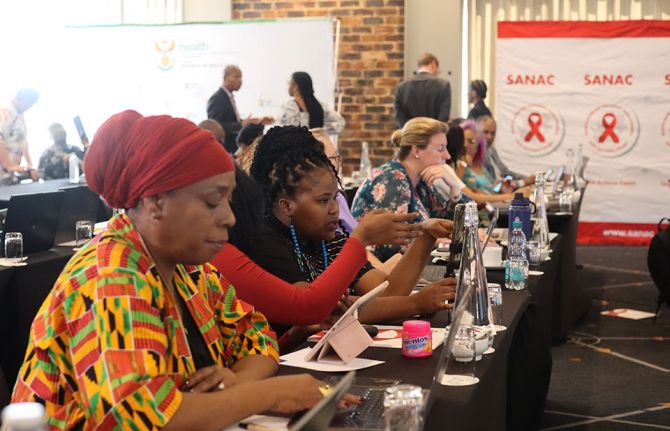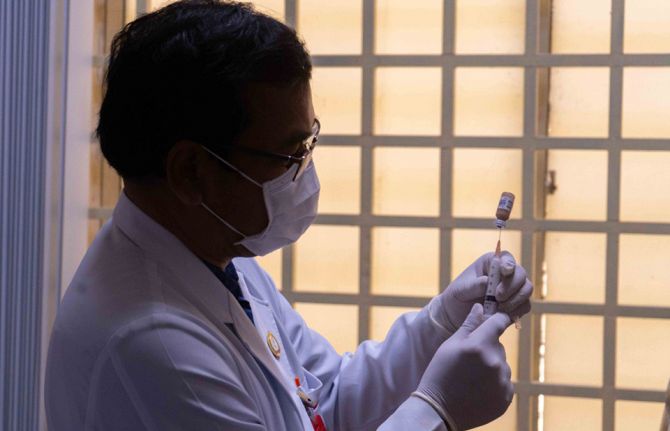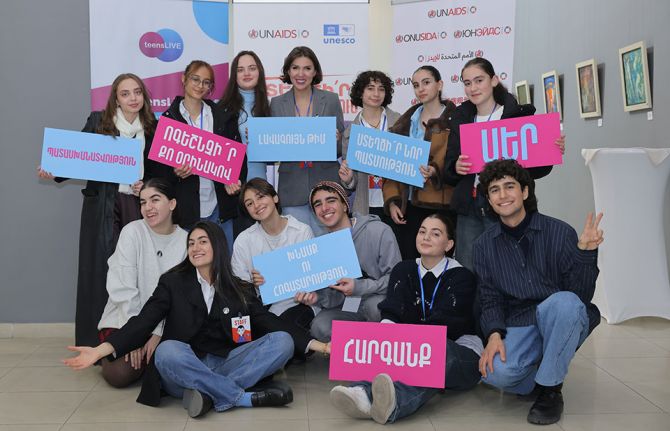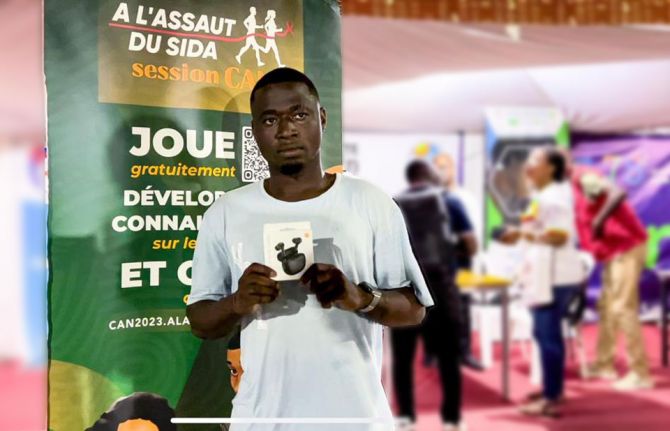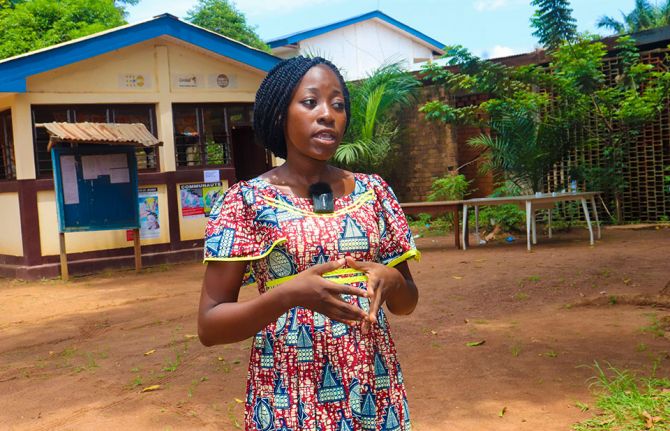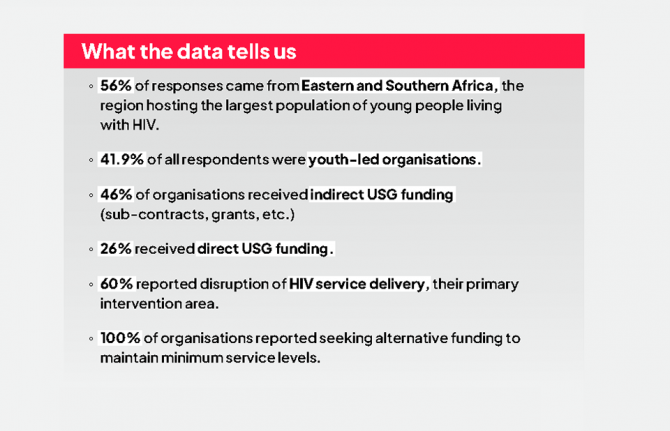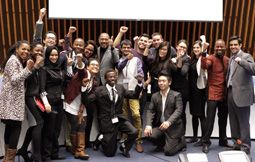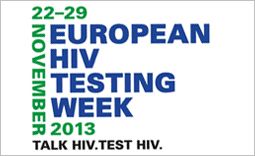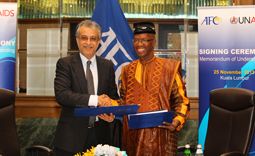
Feature Story
“Right for you!” Satellite puts young people centre stage at Vienna
22 July 2010
22 July 2010 22 July 2010 Right for you! satellite. Credit: UNAIDS/Anna Rauchenberger
Right for you! satellite. Credit: UNAIDS/Anna RauchenbergerThe thoughts and voices of young people took centre stage at the Vienna AIDS Conference yesterday as an innovative satellite session explored how they can best protect themselves from HIV. The session was organized by UNAIDS, UNESCO, UNFPA, UNICEF and WHO. It provided an interactive platform for youth from around the world to discuss sexual and reproductive health services and provision of comprehensive information including sexuality education, condom use and HIV counselling and testing.
Called ‘Right for You! Creating Game Changing Strategies for HIV and Young People’, the event was structured around the outcome of an online survey, promoted across varied social media platforms, such as Facebook, Twitter, AIDSspace and Conversations for a better world, to find out what young people really think about how to mount a meaningful and effective personal challenge to HIV. It was moderated by Ms Purnima Mane, United Nations Population Fund (UNFPA) Deputy Executive Director (Programme).
The session explored how to achieve three bold goals for young people:
- Ensure at least 80% of young people in and out school have comprehensive knowledge of HIV.
- Double young people’s use of condoms during their last sexual intercourse.
- Double young people’s use of HIV testing and counselling services.
‘Empowering Young People to Protect Themselves against HIV’, is one of the priority areas of the UNAIDS Outcome Framework 2009-2011. The aim is to reduce new HIV infections among young people by 30% by 2015.
The three goals discussed in yesterday’s satellite are far-reaching and ambitious in scope. They were highlighted in the UNAIDS business case on empowering young people. The business case is an advocacy tool which outlines why UNAIDS has prioritized young people and it recommends that the three results should be achieved in at least 9 of the 17 countries that have largest number of young people living with HIV by 2011, as well as in countries experiencing low and concentrated epidemics.
Those gathered at the event discussed how such results can be achieved and how the necessary good quality programmes can be scaled up at country level. An expert panel that included a youth facilitator, Ishita Chaudhry from India, Dr Doug Kirby, co-author of International Technical Guidance on Sexuality Education: An evidence informed approach for schools, teachers and health educators, Darlington Muyambwa, Programme Manager, SAYWHAT Programme, Zimbabwe , and Shaffiq Essajee, WHO, responded to feedback from participants who expressed their views or asked questions via the web forums.
Exploring ways of empowering young people to protect themselves against HIV is vitally important given latest estimates showing that 15-24 year olds account for some 40% of all adult HIV infections globally. In 2007, far fewer than half of young people around the world had accurate knowledge about HIV.
Additionally, in many parts of the world young people have inadequate access to sexual and reproductive health services and commodities like condoms. Socio-cultural norms can act as barriers to these essential services and commodities which discourage young people from learning about and discussing sex and sexuality and accessing the services. The session explored ways to address these challenges and empower young people to make informed decisions about this key aspect of their lives.
Right Hand Content
Related

Feature Story
Helping Vietnamese youth protect themselves against HIV
16 June 2010
16 June 2010 16 June 2010 “This is a unique experience with the UN I’ve never seen elsewhere,” said Lisa Sherburne, an HIV specialist with Save the Children. Credit: UN
“This is a unique experience with the UN I’ve never seen elsewhere,” said Lisa Sherburne, an HIV specialist with Save the Children. Credit: UNPham Xuan Tung talks eagerly and takes notes for his group during a biology lesson on HIV transmission and the replication of the virus in blood cells. This new type of highly interactive class is something Tung, a student at Hoang Quoc Viet upper secondary school in Dong Trieu District, Quang Ninh Province, clearly enjoys.
The class is based on a new, integrated reproductive health and HIV prevention curriculum for secondary school students being developed and piloted by the Ministry of Education and Training (MOET), with support from UNICEF, UNFPA, UNESCO and Save the Children in Viet Nam. Many students in Quang Ninh Province, Quang Tri Province and Ho Chi Minh City are following the new pilot curriculum.
A comprehensive national HIV prevention curriculum

Many students in Quang Ninh Province, Quang Tri Province and Ho Chi Minh City are following the new pilot curriculum. Credit: UN
“I have seen a positive change in the participation of students in my class. The new teaching and learning method allows room for every student to speak up, and they are much more responsive,” said Tung’s teacher Truong Thi Hoa.
The new curriculum for secondary schools nationwide draws on UN-supported work in schools, including healthy living and life skills programmes, reproductive health and HIV prevention initiatives, and pre-service training for teachers. Integrating the areas into core lessons and extra-curricular activities, it includes special training for parents so they can better discuss HIV and reproductive health issues with their children – subjects that can be particularly sensitive and difficult to address.
I have seen a positive change in the participation of students in my class. The new teaching and learning method allows room for every student to speak up, and they are much more responsive.
Truong Thi Hoa, teacher
“This is a unique experience with the UN I’ve never seen elsewhere,” said Lisa Sherburne, an HIV specialist with Save the Children. “It allows more resources, more cohesive actions and a more powerful voice for the Viet Nam education sector.”
The changes are all aimed at integrating HIV prevention into the next national curriculum framework and new textbooks to be developed by the ministry and approved by the National Assembly in 2015.
However, many challenges remain. The ministry needs strong political leadership and greater capacity for planning and coordination, sufficient resources, teachers with better capacity, and effective intra-ministry and multisectoral coordination.
“Our biggest challenge is how to facilitate the close collaboration among departments in the ministry and among ministries related to the education sector response to HIV,” says La Quy Don, vice director of MOET’s Department of Student Affairs.
For Eamonn Murphy, UNAIDS Viet Nam Country Director, this is also a top priority. “We are committed to providing joint support for policy-making, enhanced coordination and implementation of several key aspects of the education sector’s response to HIV.”
Empowering young people to protect themselves against HIV is a key priority area in UNAIDS Outcome Framework 2009-11.
Right Hand Content
Cosponsors:
Partners:
Feature stories:
Sexuality education an imperative for children and young people in a world affected by AIDS (10 December 2009)
UNAIDS Task Team develops effective tools to help young people tackle HIV (05 June 2009)
HIV response and the education sector: UNESCO Best practice series (04 May 2009)
Publications:
A Strategic Approach: HIV & AIDS and Education UNAIDS IATT on Education, 2008 (pdf, 327 Kb.)

Feature Story
Sexuality education an imperative for children and young people in a world affected by AIDS
10 December 2009
10 December 2009 10 December 2009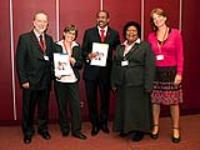
(From L to R) Mark Richmond, UNESCO’s Global Coordinator on HIV and AIDS, Dr Mariangela Batista Galvao Simao, Director, Brazil National STD/AIDS Programme, Michel Sidibé, UNAIDS Executive Director, Elizabeth Mataka, member of the Global Advisory Group on Sexuality Education and the UN Secretary-General’s Special Envoy for AIDS in Africa and Marijke Wijnroks, the AIDS ambassador for the Netherlands
Credit: UNAIDS/D.Bregnard
In many parts of the world, a combination of social taboos, unavailability of sound information, lack of resources and infrastructure make it difficult for children and young people to access sexuality education aimed at improving knowledge and reducing risk. This leaves many young people vulnerable to coercion, abuse, exploitation, unintended pregnancy and sexually transmitted infections, including HIV.
According to the UNAIDS 2008 Global Report on the AIDS Epidemic, only 40% of young people aged 15-24 had accurate knowledge about HIV and transmission. It should come as no surprise that, against this background of insufficient levels of basic knowledge, young people aged 15-24 account for 40% of all new HIV infections (UNAIDS 2009 AIDS Epidemic Update).
In response to this challenge, the voluntary and non-mandatory International Technical Guidance on Sexuality Education developed by UNESCO in partnership with UNAIDS, UNFPA, UNICEF and WHO seeks to assist education, health and other relevant authorities to develop and implement school-based sexuality education materials and programmes. The International Technical Guidance on Sexuality Education is based on a rigorous review of evidence on sexuality education programmes and is aimed at education and health sector decision-makers and professionals.
If we are to make an impact on children and young people before they become sexually active, comprehensive sexuality education must become part of the formal school curriculum, delivered by well trained and supported teachers.
Michel Sidibé, UNIADS Executive Director
Sexuality education can play a key role in improving knowledge and reducing sexual risk behaviours among young people. Equipped with better knowledge, information and skills, young people can be empowered to make informed decisions about sexual choices.
“If we are to make an impact on children and young people before they become sexually active, comprehensive sexuality education must become part of the formal school curriculum, delivered by well trained and supported teachers,” says Michel Sidibé, UNAIDS Executive Director. “Teachers remain trusted sources of knowledge and skills in all education systems and they are a highly valued resource in the education sector response to AIDS.”
The International Technical Guidance on Sexuality Education was co-authored by leading experts in the field of sexuality education and subjected to extensive review and comment by a global panel of experts and practitioners from civil society organizations, ministries of education and international agencies. Volume I of the International Technical Guidance on Sexuality Education focuses on the rationale for sexuality education and provides sound technical advice on characteristics of effective programmes. It is the outcome of a rigorous review of the literature on the impact of sexuality education and sexual behaviour, drawing upon 87 studies from around the world.
Numerous studies show that with the right information and skills, young people can change their behaviour to reduce the risk of acquiring HIV infection or passing it on to others.
Mark Richmond, UNESCO’s Global Coordinator on HIV and AIDS
A companion document (Volume II) focuses on the topics and learning objectives to be covered in a ‘basic minimum package’ on sexuality education for children and young people from 5 to 18+ years of age and includes a bibliography of useful resources. It was informed by a review of curricula from 12 countries, as well as other international models.
“Numerous studies show that with the right information and skills, young people can change their behaviour to reduce the risk of acquiring HIV infection or passing it on to others,” says Mark Richmond, UNESCO’s Global Coordinator on HIV and AIDS and the Director for the Division for the Coordination of UN Priorities in Education. “At a minimum, HIV and AIDS education needs to include information on the HIV virus and its modes of transmission. At some point, HIV and AIDS education must introduce sex and relationships education - simply because over 75% of all HIV infections occur through sexual transmission.”
The UN organizations called on policy-makers to listen to young people, families, teachers and other practitioners, and use the International Technical Guidance to make sexuality education an integral part of the national response to the HIV pandemic.
UNESCO and its partners including UNAIDS, UNFPA, UNICEF and WHO, as well as a wide range of other partners, will support governments in operationalising the International Technical Guidance on Sexuality Education at regional and country level. The two volumes of the International Technical Guidance will be published in all the six UN languages (Arabic, Chinese, English, French, Russian and Spanish) as well as Portuguese.
Sexuality education an imperative for children an
Key populations:
Cosponsors:
Feature stories:
Michel Sidibé calls for prevention revolution in opening address at UNAIDS’ governing body meeting (08 December 2009)
Preventing HIV through education in Latin America and Caribbean (31 July 2009)
New publication champions a strategic approach to HIV and education (15 June 2009)
Publications:
International Technical Guidance on Sexuality Education (Volume-I) (pdf, 2.84 Mb.)
International Technical Guidance on Sexuality Education (Volume-II) (pdf, 1.94 Mb.)

Feature Story
Education sector: Getting to grips with an HIV monitoring and evaluation framework
23 November 2009
23 November 2009 23 November 2009Credit: UNAIDS/L. Taylor
The education sector plays a critical role in national responses to the HIV epidemic. However, this contribution is often poorly appreciated and understood due to limited, difficult-to-measure data and the absence of agreement on core indicators for the sector.
To assist ministries of education and their partners in measuring progress and outcomes of related efforts, a host of international experts met in London on 9-10 November to develop a monitoring and evaluation (M&E) framework for education sector responses to AIDS. This framework aims to assist ministries of education and other partners in outlining and measuring the main programme outputs and outcomes of the education sector, facilitating the development of effective, results-focused interventions.
Convened by the Partnership for Child Development (PCD) of Imperial College, on behalf of the Indicators Working Group of the UNAIDS Inter-Agency Task Team (IATT) on Education, the experts attending the meeting included individuals with significant expertise in M&E, in education sector responses and with a great deal of programme experience. Programme managers from Southern Africa, Latin America and the Caribbean, and South and South-East Asia attended.
Getting things right in the education sector’s monitoring and evaluation of its response to HIV is essential if it is to provide a ‘social vaccine’ to the epidemic, offering knowledge and personal skills which can prevent HIV.
Michael Beasley, director of Partnership for Child Development at Imperial College London
The meeting built on a review of existing indicators used to monitor education sector HIV responses undertaken by PCD on behalf of the UNAIDS IATT on Education Indicators Working Group. It also contributed to an effort underway by a wide range of partners associated with the FRESH (Focusing Resources on Effective School Health) Initiative to develop an M&E framework for school-based health and nutrition and HIV prevention interventions.
As well as reaching agreement on appropriate priorities for the monitoring and evaluation of the sector’s work, the meeting also achieved consensus on prioritising indicators that could be used.
Indicators examined included those helping the education sector address the following questions:
1. Within the context of a national AIDS response, is there a response in the education sector that is guided and enabled by policy, strategy and resources?
2. Is HIV, reproductive and sexual health education a timetabled subject delivered in schools? Is it mandatory and assessed? Are HIV-related life skills delivered through co-curricular means?
3. Are educators receiving pre-service and in-service training about HIV (for themselves) and about teaching HIV to students?
4. Is the education sector facilitating testing, treatment, care and support services for learners and educators? Are measures in place to make schools safe and protective environments?
In addition to indicators to measure these short-term outcomes, the group also considered intermediate outcomes such as knowledge about HIV and those of a long-term nature such as age of sexual debut.
The draft M&E framework and proposed indicators will be presented to the UNAIDS IATT on Education at its meeting on 2-4 December 2009 in Berlin, Germany. Anticipated next steps include field-testing the new proposed indicators, and refining the definitions of existing ones. This will be taken forward by members of the IATT on Education’s Indicators Working Group in early 2010, in consultation with ministries of education and national partners.
According to Michael Beasley, director of Partnership for Child Development at Imperial College, “Getting things right in the education sector’s monitoring and evaluation of its response to HIV is essential if it is to provide a ‘social vaccine’ to the epidemic, offering knowledge and personal skills which can prevent HIV.” He added, “It is estimated that young people who fail to complete a basic education are more than twice as likely to become infected as those who do. Education also reduces the vulnerability of girls, and each year of schooling offers greater protective benefits.”
Empowering young people to protect themselves from HIV is one of the nine priority areas for UNAIDS and its Cosponsors under the Joint Action for Results: UNAIDS Outcome Framework 2009-2011.
Formed in 2002, the UNAIDS IATT on Education is convened by UNESCO and brings together UNAIDS Cosponsors and other multilateral organisations, bilateral agencies, private donors and civil society partners with the purpose of accelerating and improving a coordinated and harmonised education sector response to HIV.
Education sector: Getting to grips with an HIV mo
Cosponsors:
Feature stories:
China’s vocational schools play a key role in AIDS education (16 October 2009)
UNAIDS Task Team develops effective tools to help young people tackle HIV (05 June 2009)
HIV response and the education sector: UNESCO Best practice series (04 May 2009)
Publications:
A review conducted on behalf of the UNAIDS IATT on Education Indicators Working Group (pdf, 508 Kb.)
A Strategic Approach: HIV & AIDS and Education UNAIDS IATT on Education, 2008 (pdf, 2.44 Mb.)
Toolkit for Mainstreaming HIV and AIDS in the Education Sector: Guidelines for Development Cooperation Agencies. (UNAIDS IATT on Education, 2008) (pdf, 1 Mb.)
Related

Feature Story
Injecting drug users take central role in anti-stigma film
10 August 2009
10 August 2009 10 August 2009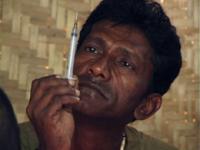
A frame from the film Suee (Needle), unveiled during the satellite session, ‘Reforming treatment environments – How to make compulsory drug treatment HIV friendly’ at ICAAP09.
The lives of injecting drug users and the HIV-related stigma and discrimination they face was one focus of the IX International Congress on AIDS in Asia and the Pacific as the film Suee (Needle) was launched by Response Beyond Borders, the Asian consortium on drug use HIV, AIDS and poverty.
Unveiled during the satellite session, ‘Reforming treatment environments – How to make compulsory drug treatment HIV friendly’, the film gives a voice to this vulnerable group with anti-stigma messages conveyed by the injecting drug users themselves. It was directed by award-winning Indian movie director, author and screen-writer, Sai Paranjpye, who set out to present an uncompromising insight into a world where HIV prevalence is disproportionately high.
Ms Paranjpye, a Cannes Film Festival award winner, worked closely with injecting drug users on Suee and spent time interviewing them on location and involving them as actors in the film. They ‘own’ the project as much as is practically possible. She also consulted a full range of partners and obtained feed back on the script and other help from NGOs working in HIV prevention with injecting drug users, especially Sharan in Delhi and Sankalp in Mumbia. She also received input from the International Center for Research on Women and World Bank teams, among others.
Suee explores a number of areas in the lives of injecting drug users including treatment, care, peer and community support, rehabilitation and the workplace. It is intended to convey messages of hope and not to trigger reactions of pity or fear; empowering the audience by raising awareness and presenting facts in a non-judgmental way. Made for general consumption, the film can also be used in youth campaigns, providing education and information for young people to help prevent HIV and reduce both risk and vulnerability.
The film emerged from the South Asia Region Development Marketplace (SAR DM), an initiative spearheaded by the World Bank. It consists of a competitive grants programme that identifies and supports small scale projects demonstrating an innovative approach to reducing HIV stigma and discrimination in the region. 26 civil society organisations from across South Asia won grants of US$ 40,000 each to bring their ideas to fruition.
Ms Paranjpye has used her SAR DM award to produce not only the Suee film but another, called “The sound of the horn”, which deals with truck drivers.
Stigma and discrimination are seen as major barriers to scaling up HIV prevention services in the region. They marginalise those living with the virus and contribute to their social isolation and rejection. They also discourage vulnerable groups from accessing HIV treatment, care and support services.
It is hoped that Suee, once widely disseminated, will take its place among a range of interventions helping to reduce stigma and discrimination against South Asia’s injecting drug users.
The film was selected by the screening committee of the Congress and will be shown again on August 11.
Note: Partners and sponsors of the South Asia Region Development Marketplace include: UNAIDS, UNICEF, UNODC, UNDP, the Global Fund, the Government of Norway, the International Center for Research on Women, the International Finance Corporation, and the Swedish International Development Cooperation Agency (SIDA)
Injecting drug users take central role in anti-st
IX International Congress on AIDS in Asia and the Pacific
South Asia Region Development Marketplace
Cosponsors:
World Bank
United Nations Children’s Fund
United Nations Office on Drugs and Crime
United Nations Development Programme
Partners:
Sankalp Rehabilitation Trust
Sharan
International Center for Research on Women
The Global Fund to Fight AIDS, Tuberculosis and Malaria
International Finance Corporation
Swedish International Development Cooperation Agency
Feature stories:
Migrant workers and HIV vulnerability in South Asian and South East Asian countries (18 may 2009)
'Never abandon, never give up’: ILO film helps China’s migrant workers challenge AIDS stigma (30 April 2009)
International Harm Reduction conference opens in Bangkok (20 April 2009)
OPINION: HIV and drugs: two epidemics - one combined strategy (20 April 2009)
‘Love and Relationships’: Film festival in Cambodia addresses HIV prevention (06 April 2009)
UNODC and Iran sign agreements to reduce vulnerability of women and Afghan refugees to drugs and HIV (24 March 2009)
Injecting drug use and HIV: Interview with UNAIDS Team Leader, Prevention, Care and Support team (11 march 2009)
OPINION: Silence on harm reduction not an option (11 March 2009)

Feature Story
More needs to be done to help young people most at risk of HIV infection
10 August 2009
10 August 2009 10 August 2009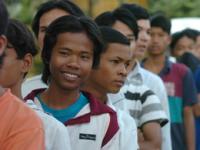
Credit: UNAIDS/O.O'Hanlon
In general, HIV prevention services in the Asia region are currently not reaching young people who are most at risk of infection, which include those who inject drugs, who engage in unprotected male to male sex and those involved in sex work and their clients. In order to address this situation the Asia Pacific Regional UN Coordination Group on Most at Risk Young People hosted a symposium at the IX International Congress on AIDS in Asia and the Pacific.
According to epidemic models presented in the 2008 AIDS in Asia Commission report, over 95% of all new HIV infections in the Asia region occur among such most at risk young populations. However, over 90% of resources for young people as a group are spent on low-risk youth, who represent less than 5% of infections.
Entitled "HIV prevention and most at risk young people", the event was sponsored jointly by UNFPA, UNICEF, UNESCO, UNAIDS, UNDP, WHO and is supported by 7Sisters, the Coalition of Asia Pacific Regional Networks on HIV/AIDS. It examined, among other issues, how the specific needs of most at risk young people should be addressed, what works and what doesn't and how partnerships between youth, NGOs and government can be strengthened.
The symposium discussed the nexus of unsafe sexual behaviours among most at risk young people where a number of such practices coexist in the same environment. Sex work, drug use and unprotected sex with multiple partners can all occur in the same social network. Therefore, participants looked at an approach which addresses a multiplicity of needs, meshing and coordinating previously implemented programmes and ensuring a youth-friendly approach.
A comprehensive, evidence-informed response, it was argued, requires firm commitment from donors and governments to address the specific needs of most at risk young people, and an examination of the contexts in which these risks occur. The engagement of this group in developing the policies, programmes and processes that directly affect and benefit them is seen as a prerequisite. Young people played an active and central role in this event as the practical aspect of exactly how to get youth involved in decision making was explored.
Specific objectives of the meeting also included promoting awareness among policy makers and programme planners on the urgent need for HIV prevention for most at risk young people and encouraging increased collection, analysis and use of data on this key group to support advocacy efforts and inform budget allocation priorities. Sharing experience of programming in this area, both positive and not so positive, was on the agenda too.
Among those taking part in the event were the UNFPA's Deputy Executive Director (Programme), Purnima Mane. UNESCO’s Jan de Lind van Wijngaarden, and UNICEF’s Margaret Sheehan spoke on behalf of the Asia Pacific Regional UN Coordination Group on Most at Risk Young People. James Chau, member of the AIDS2031 initiative, UNAIDS Goodwill Ambassador and Chinese television presenter facilitated the panel discussion. The panel also involved representatives of the medical profession, NGOs, health ministries and representatives of young people involved in sex work, drug use and male to male sex.
More needs to be done to help young people most a
IX International Congress on AIDS in Asia and the Pacific
Cosponsors:
Partners:
7Sisters, the Coalition of Asia Pacific Regional Networks on HIV/AIDS
Feature stories:
International Harm Reduction conference opens in Bangkok (20 April 2009)
OPINION: HIV and drugs: two epidemics - one combined strategy (20 April 2009)
Swing and Sisters: HIV outreach to sex workers in Thailand (19 March 2009)
Injecting drug use and HIV: Interview with UNAIDS Team Leader, Prevention, Care and Support team (11 march 2009)
OPINION: Silence on harm reduction not an option (11 March 2009)
Spotlight: men who have sex with men and HIV (16 February 2009)
Hidden HIV epidemic amongst MSM in Eastern Europe and Central Asia (26 January 2009)
HIV prevention hampered by homophobia (13 January 2009)
Publications:
UNAIDS Action Framework: Universal Access for Men who have Sex with Men and Transgender People (pdf, 323 Kb.)
Framework for monitoring and evaluating prevention programmes for most-at-risk-populations (pdf, 1.49 Mb.)
Policy Brief: HIV and Sex between men (pdf, 277 Kb.)

Feature Story
UNAIDS Cosponsors out in force for 9th ICAAP
09 August 2009
09 August 2009 09 August 2009
The 10 UNAIDS Cosponsors are presenting a strong showing as thousands of delegates converge in Bali, Indonesia, to share ideas, knowledge, best practices, lessons learned and research findings at the 9th International Congress on AIDS in Asia and the Pacific (ICAAP).
The Cosponsors are an integral part of the UN’s response to the global AIDS epidemic and UNAIDS brings together their efforts and resources.
Echoing the Congress theme, ‘Empowering people - strengthening networks’, the Cosponsors are organising and presenting symposia, skills-building workshops and satellite meetings drawing together a number of participants from a range of disciplines with the aim of helping to build and nurture partnerships to bolster the AIDS response in the region.
A number of events are joint Cosponsor initiatives. For example, the Symposium on ‘HIV prevention and most at risk young people’, taking place on 10 August, is sponsored by UNFPA, UNICEF, UNESCO, UNDP, WHO and UNAIDS. The symposium, hosted by the Asia Pacific Regional UN Coordination Group on Most at Risk Young People, is designed to look at the specific needs of this population which is, in general, not being reached by HIV prevention services. This includes injecting drug users, men who have sex with men and sex workers and their clients. Representatives from these groups will also take part in the panel discussion –one further example of how Cosponsor ICAAP activities are designed to involve key populations.
Other examples of Cosponsor activities include UNDP, ILO and UNAIDS (with the Joint United Nations Initiative on Mobility and HIV/AIDS in South East Asia) collaborating on a joint symposium on 12 August entitled, ‘The Impact of the Financial Crisis on Labour Migration and HIV’ in which they will bring their respective expertise to bear on this pressing international issue. UNHCR, along with UNAIDS, is hosting a satellite session on 12 August called ‘Opportunities and challenges in addressing HIV amongst diverse humanitarian populations’. WFP will use a satellite session on 11 August to explore the vital role of nutrition and food security for people living with HIV and will, along with its partners, look at ‘Models for integrating nutrition and food security into HIV care, support and treatment in the Asia Region: Opportunities and challenges’.
The World Bank is also championing the screening, on 10 August, of the film, Suee (Needle) by Cannes Film Festival award winner, Sai Paranjpye, which deals with the lives of injecting drug users and the anti-AIDS stigma they face. The film emerged from the South Asia Region Development Marketplace, a grant programme spearheaded by the Bank and supported by a range of partners including UNAIDS, UNICEF, UNODC and UNDP.
There is an extremely broad range of other Cosponsor activities taking place over the five days of the Congress and a number of these events will be highlighted on the UNAIDS website as the ICAAP progresses.
UNAIDS and its ten Cosponsors work to provide technical support to countries to assist them in the implementation of their national AIDS plans. A ‘division of labour’ guides the technical support provided to enhance coordination, avoid duplication and provide the best assistance available. Each of the Cosponsor organizations leads in at least one technical area. These organizations are:
Office of the United Nations High Commissioner for Refugees (UNHCR)
United Nations Children's Fund (UNICEF)
United Nations Development Programme (UNDP)
United Nations Population Fund (UNFPA)
United Nations Office on Drugs and Crime (UNODC)
International Labour Organization (ILO)
United Nations Educational, Scientific and Cultural Organization (UNESCO)

Feature Story
New publication champions a strategic approach to HIV and education
15 June 2009
15 June 2009 15 June 2009
According to A Strategic Approach: HIV & AIDS and Education, this sector can play a central part in the response to HIV by “doing more of what it is doing already and doing it better.”
Credit: UNESCO
Education can play a critical role in the global challenge to HIV simply by “doing more of what it is doing already and doing it better,” and ensuring that all children have access to good quality learning. This is a key conclusion emerging from a new publication by the UNAIDS Inter-Agency Task Team (IATT) on Education which explores what is already known and what needs to be learned about expanding the education sector’s response to the epidemic.
A Strategic Approach: HIV & AIDS and Education is being launched this week at the IATT Symposium taking place in Limerick, Ireland, by Peter Power T.D., Minister of State for Overseas Development. It examines how education can help mitigate the effects of HIV and how this key sector should be an integral part of any national AIDS programme. The report, an extensive update on a previous 2003 publication, highlights the fact that education in itself provides protection against the virus and that more and better schooling should therefore be the first line of the response. A second and complementary measure is the introduction of specific actions tailored to the epidemic, such as the provision of HIV and sexuality education.

Credit: UNESCO
Michel Sidibé, UNAIDS Executive Director, states in the publication’s foreword that “Education is empowering. It facilitates the acquisition and use of knowledge, competencies, attitudes and behaviours that are essential for healthy lifestyles….it enhances public accountability, promotes inter-generational dialogue and leads to better use of available services, especially health and social protection.” He adds: “education can address the social, cultural and economic conditions that contribute to increased vulnerability...”
Aimed at decision-makers and practitioners in the field of education and their partners working on the AIDS response in other sectors, A Strategic Approach: HIV & AIDS and Education identifies key priorities.
Education is empowering. It facilitates the acquisition and use of knowledge, competencies, attitudes and behaviours that are essential for healthy lifestyles….it enhances public accountability, promotes inter-generational dialogue and leads to better use of available services, especially health and social protection.
Michel Sidibé, UNAIDS Executive Director
There is an emphasis on ‘knowing your epidemic’ so that each response is tailor-made to fit the local epidemiological reality. It also argues for two central objectives: first, the prevention of HIV (including the reduction of both social vulnerability and individual risk-taking) and, second, the mitigation of the impact of AIDS.
The report also contends that young people should be given access to the full range of information and resources so that they can protect themselves effectively. This requires that curriculum and learning materials be available in clear and understandable language and that HIV and sexuality education be delivered in an age-appropriate and culturally sensitive manner. Education should “comprehensively cover” such issues as relationships, sexual networks (including same-sex relations) and drug use. However, the publication also points to a recent study among young people in Africa by the Guttmacher Institute which shows that although most teenagers think sex education should be taught in schools, less than half of them receive it.

Credit: UNESCO
A Strategic Approach: HIV & AIDS and Education is primarily focused on school-based learning but it recognises that many of the young people most at risk have often never been to school or have dropped out. This demonstrates the importance not only of reaching out-of-school young people but of enlarging the provision of education, making sure more girls attend school and that greater numbers of children make the transition from primary to secondary institutions.
Empowering young people to protect themselves from HIV is one of the eight priority focus areas for UNAIDS and its Cosponsors under the Joint action for results: UNAIDS outcome framework 2009-2011. Through A Strategic Approach: HIV & AIDS and Education, the UNAIDS Inter-Agency Task Team hopes that this central aim can be brought a step closer to being realised.
Formed in 2002, the IATT on Education is convened by UNESCO and brings together UNAIDS Cosponsors, bilateral agencies, private donors and civil society partners with the purpose of accelerating and improving a coordinated and harmonised education sector response to HIV.
Copies of A Strategic Approach: HIV & AIDS and Education can be requested free of charge from info-iatt@unesco.org Please specify quantity, language version(s), and mailing address. If you are requesting more than 5 copies, please state intended use.
New publication champions a strategic approach to
Cosponsors:
Feature stories:
UNAIDS Task Team develops effective tools to help young people tackle HIV (05 June 2009)
Global online forum to give teachers a voice on HIV (14 may 2009)
HIV response and the education sector: UNESCO Best practice series (04 May 2009)
Supporting young learners living with HIV in Namibia and Tanzania (23 December 2008)
ICASA 2008: Courage and hope, African teachers living positively (03 December 2008)
Publications:
A Strategic Approach: HIV & AIDS and Education ( En | Fr | Es ) (pdf, 2.44 Mb. | 2.31 Mb. | 2.27 Mb.)
Toolkit for Mainstreaming HIV and AIDS in the Education Sector: Guidelines for Development Cooperation Agencies. (UNAIDS IATT on Education, 2008) ( En | Fr | Es ) (pdf, 1.01 Mb. | 904 Kb. | 1.02 Mb.)
Advocacy Briefing Notes – Girls’ Education and HIV Prevention. (UNAIDS IATT on Education, 2008) (pdf 252 Kb.)
Advocacy Briefing Notes – HIV and AIDS Education in Emergencies. (UNAIDS IATT on Education, 2008) (pdf, 275.6 Kb.)
Advocacy Briefing Notes – Mainstreaming HIV in Education. (UNAIDS IATT on Education, 2008) (pdf, 277.1 Kb.)
Advocacy Briefing Notes – Teachers Living with HIV and AIDS. (UNAIDS IATT on Education, 2008) (pdf, 273 Kb.)
UNESCO: Good Policy and Practice in HIV & AIDS and Education Series
Booklet 1: Overview
(pdf, 2.62 Mb.)
Booklet 2: HIV & AIDS and Safe, Secure and Supportive Learning Environments
(pdf, 5.06 Mb.)
Booklet 3: HIV & AIDS and Educator Development, Conduct and Support
(pdf, 1.06 Mb.)
Booklet 4: Partnerships in Practice (pdf, 5.11 Mb.)
Booklet 5: Effective Learning (pdf 3.70 Mb.)
Related
 “Who will protect our young people?”
“Who will protect our young people?”

02 June 2025

Feature Story
Global online forum to give teachers a voice on HIV
14 May 2009
14 May 2009 14 May 2009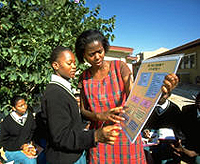
The global online forum will give teachers and their partners the chance to exchange ideas and expertise on how to challenge HIV more effectively
Credit: UNAIDS G. Pirozzi
Teachers have a critical role to play in mounting a successful response to HIV in schools and yet evidence of effective teacher involvement in the challenge to the epidemic is scarce and scattered and lessons learned have not been universally discussed and shared.
In order to review progress made and identify ways forward, UNESCO's International Institute for Educational Planning (IIEP) and the UNAIDS Inter-Agency Task Team on Education are organizing an E-Forum on ‘Teachers and HIV & AIDS: Reviewing achievements, identifying challenges’ from 18 to 29 May 2009.
The forum will bring together a wide range of actors including educational planners, policy-makers, representatives of teachers' unions and teaching staff, networks of teachers living with HIV, civil society groups, donors, UNAIDS cosponsors and other multilateral agencies. They will exchange views and experiences and explore how teachers can capitalize on their influence and expertise to mitigate the effects of an epidemic which is having a profound and negative impact on schools and entire education systems.
In many countries, curricula now include AIDS-related content and teachers themselves are often taking the lead. For example, the South African Democratic Teachers’ Union is building institutional capacity, providing training to support colleagues in examining their own vulnerability to infection, their awareness about HIV and their attitudes towards helping others avoid infection. Educators in general are given an important responsibility to ensure that children and young people acquire essential knowledge, skills and attitudes for prevention and that, in higher prevalence settings, pupils infected with and affected by HIV have access to care and support.

Credit: UNESCO
Without teachers, the endeavour to provide Education for All, which aims to meet the learning needs of every child, youth and adult by 2015, cannot be achieved. However, these professionals face profound challenges, including often difficult working environments (overcrowded classrooms, lack of materials) and poor or non-existent training. In many contexts, particularly in sub-Saharan Africa, teachers are profoundly affected by HIV. According to UNAIDS and WHO, in Zambia, for example, it is estimated that teacher illness (often AIDS-related) and the responsibilities of caring for family members, including attending funerals, account for over 60% of teacher absences. Additionally, stigma and discrimination, gender inequality, concerns around morality, cultural issues and relationships between teachers and students can make the environment in which school-based AIDS education occurs highly complex.
According to a joint statement by Mark Richmond, UNESCO’s Global Coordinator on HIV and AIDS and Mark Bray, Director of UNESCO’s IIEP, “The AIDS epidemic is raising many issues for the teaching profession, particularly in high prevalence settings.”
This forum promises to be a valuable opportunity… to enable the voices of teachers to be heard by all those responding to the challenges posed by HIV.
Mark Richmond, UNESCO’s Global Coordinator on HIV and AIDS and Mark Bray, Director of UNESCO’s IIEP
“This forum promises to be a valuable opportunity for teachers and other stakeholders to share their knowledge and experience and, even more importantly, to enable the voices of teachers to be heard by all those responding to the challenges posed by HIV,” they continued.
The outcomes of the Forum will feed directly into the Spring Meeting of the UNAIDS IATT on Education, hosted by Irish Aid, the Irish government’s assistance programme for developing nations. Taking place in June this year, the meeting has 'Teachers and HIV & AIDS: Reviewing achievements, identifying challenges' as its Symposium theme.
A report on the discussion will also be more widely available at the IIEP's HIV and AIDS Education Clearinghouse.
The Forum will invite the exchange of views on four interrelated sub-topics:
1. Involving teachers in HIV prevention - policy and management implications
2. Coverage and content of pre- and in- service training for teachers
3. The role of teachers in child protection and promotion of safe and healthy school environments
4. Supportive and enabling environments for teachers affected by HIV
All four sub-topics will be accessible over the course of the Forum which will be animated by e-moderators (IIEP and UNAIDS IATT Secretariat staff), with daily syntheses of discussions and commentary to guide further debate on these issues.
To join the Forum, please send an e-mail message to: hiv-aids-clearinghouse@iiep.unesco.org, stating your name, title, organization and nationality. You will then be sent detailed instructions on how to access the Forum and contribute to the discussion.
Please note that you can sign up at any time prior to or during the Forum but that it will be active only from 18 May.
For more information on the IATT Symposium in Ireland, please contact: info-iatt@unesco.org
Right Hand Content
Cosponsors:
Feature stories:
HIV response and the education sector: UNESCO Best practice series (04 May 2009)
Supporting young learners living with HIV in Namibia and Tanzania (23 December 2008)
ICASA 2008: Courage and hope, African teachers living positively (03 December 2008)
Publications:
Booklet 1: Overview (pdf, 2.62 Mb.)
Booklet 2: HIV & AIDS and Safe, Secure and Supportive Learning Environments (pdf, 5.06 Mb.)
Booklet 3: HIV & AIDS and Educator Development, Conduct and Support (pdf, 1.06 Mb.)
Booklet 4: Partnerships in Practice (pdf, 5.11 Mb.)
Booklet 5: Effective Learning (pdf, 3.70 Mb.)
Toolkit for Mainstreaming HIV and AIDS in the Education Sector: Guidelines for Development Cooperation Agencies. (UNAIDS IATT on Education, 2008) ( En | Fr | Es ) (pdf, 1,01 Mb | 904 Kb. | 1.02 Mb.)
Advocacy Briefing Notes – Girls’ Education and HIV Prevention. (UNAIDS IATT on Education, 2008) (pdf 252 Kb.)
Advocacy Briefing Notes – HIV and AIDS Education in Emergencies. (UNAIDS IATT on Education, 2008) (pdf, 275 Kb.)
Advocacy Briefing Notes – Mainstreaming HIV in Education. (UNAIDS IATT on Education, 2008) (pdf, 275 Kb.)
Advocacy Briefing Notes – Teachers Living with HIV and AIDS. (UNAIDS IATT on Education, 2008) (pdf, 273.9 Kb.)
Related

Feature Story
Joint action for results: UNAIDS outcome framework, 2009 – 2011
22 April 2009
22 April 2009 22 April 2009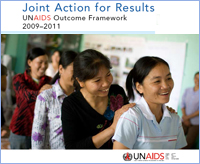
The HIV organizational landscape has evolved and grown more complex over the past decade. UNAIDS, donors and civil society, including networks of people living with HIV, have rightly demanded greater clarity on the relationships between needs, financing, activities and outcomes. Also demanded is greater specificity about the role of UNAIDS and the Secretariat within the wider constellation of actors.
This Outcome Framework, which builds upon the UNAIDS Strategic Framework (2007–2011), will guide future investment and hold the Secretariat and the Cosponsors accountable for making the resources of the UN work for results in countries. It affirms the UNAIDS Secretariat and Cosponsors to leverage our respective organizational mandates and resources to work collectively to deliver results.
Joint action for results: UNAIDS outcome framework, 2009 – 2011 (pdf, 388 Kb)
Joint action for results: UNAIDS outcome framewor
Cosponsors:
Office of the United Nations High Commissioner for Refugees (UNHCR)
United Nations Children's Fund (UNICEF)
World Food Programme (WFP)
United Nations Development Programme (UNDP)
United Nations Population Fund (UNFPA)
United Nations Office on Drugs and Crime (UNODC)
International Labour Organization (ILO)
United Nations Educational, Scientific and Cultural Organization (UNESCO)
World Health Organization (WHO)
World Bank
Publications:
Joint action for results: UNAIDS outcome framework, 2009 – 2011 (pdf, 388 Kb)



